The Grimminger Collection of Hymnals
With Dr. Daniel Grimminger
Since the time of the 16th-century Reformation, hymn singing has been very important in Western civilization. Martin Luther (1483-1546) wrote hymns, some of which were newly composed while others were adaptations of ancient Latin chant melodies and texts. Over the next 500 years, German hymns found a place in devotionals and prayer books. Verses from their texts would be chiseled in stone and carved into wood. But their most lasting home would be the hearts and minds of those who sang them from their hymn books in church and at home.
Regional Churches
In 1555, because Germany was fragmented by different religious groups, each of the regional states adopted the religious persuasion of the electors (or princes) who served them. This created a highly divided Germany that was reflected in the publication of hymnals and liturgies. Official hymn books printed in Leipzig (Saxony), for example, were Lutheran, while hymn books printed in Heidelberg (Baden-Württemberg) were German Reformed. Hymnals printed in Munich (Bavaria) later were Catholic. Regions and individual cities had their own hymnals and this accounts for the copious number of extant German hymnals and their variants on the antique market today. This huge variety of publications came to America with immigrants and contributed in colonial America to a cacophony of sound within the liturgy in many church houses.
When Pastor Heinrich Melchior Muhlenberg (1711-1787) came to America as a missionary, he found hymn singing in disarray. Hymn singing was so bad that he wrote about it in his journal on Sunday, July 1, 1751. “Our poor Lutherans” Muhlenberg remarked, “… are not able to sing even the best-known hymns, and the miserable and lamentable noise they make sounds more like a confused quarrel than a melody.” This would soon be remedied with Muhlenberg’s 1786 hymnal, Erbauliche Lieder-Sammlung (Collection of Edifying Hymns), the first official Lutheran hymn book printed in America. From this publication onward, German Lutherans would have a common hymn repertoire no matter where they or their ancestors originated. This was the beginning of the efforts to unify Lutherans in America under one book.
The Grimminger Collection
The Daniel Grimminger hymn book collection reflects both the regional tradition of German hymn book printing and the move toward unity on the American scene, from the 1600s to the present day. Sometimes called the “Samuel Putnam Collection” in scholarly publications, after the early shopkeeper who ran a store in the nineteenth-century building where this library is housed, I also call it the “Lutheran Music Foundation Collection.” It is one of the most complete Lutheran hymn book collections in private hands with approximately 2,000 hymnbooks and just as many musicological and theological works to support research in the collection.
I started to amass these books (as I did with many other things including pattern glass, silver, and walnut furniture) at a young age by scouting them out in stores, library sales, auctions, book catalogs, yard sales, and on eBay. The bulk of the regional German collection came from my friend, Louis Voigt (1925-2007), who collected them while on two sabbatical leaves from Wittenberg University (Springfield, Ohio) in Germany. He was interested in seeing our two collections come together to form something that could not be equaled anywhere else.
Much like Louie, I am an impulsive collector, picking up extra copies of the same book just in case I need trading material or know that some copies may be variant editions. Having a “complete” collection drives me from find to find. Such a goal may be more attainable with American imprints, but far more difficult when it comes to regional hymnals of Germany where there may be multiple editions of the same hymn book printed almost every year. For this reason, the regional materials from Germany are more of a sideline than the focus of my collection. The thousands of volumes in my library tell an important story of congregational singing and the creation of the great hymn repertory enjoyed by countless people since Protestantism took shape.
Among the treasures in my collection is a Leipzig imprint from 1673, a truly rare volume. Of all of the regional hymnals in Germany, those printed in Leipzig are some of the most difficult to obtain. This is likely due to the fact that Leipzigers probably used the hymnal printed in Saxony’s capital city, Dresden. The compiler-editor of this book was Johann Sebastian Bach’s predecessor at the St. Thomas Church in Leipzig. As you can see, the most unusual aspect of the book is its frontispiece (illustration facing the title page), depicting God injecting His Blood into a chalice, which is among the casks of a wine cellar—a clear reference to the Lutheran understanding of the Eucharist.
A hymnal that transcended regional or ecclesiastical imprimatur was the “Halle Hymnal.” Printed in the City of Halle, where the Pietist movement (which promoted a conversion experience and heart-felt religion) was born. This hymn book, compiled by Johann Anastasius Freylinghausen (1670-1739), was one of the first to contain both a melody and bass line for performance by keyboard players in the home. Up until the time of this publication, if a parishioner wanted to learn the music of a hymn, they would need to study it in the books used by the church and its musicians. Because of the Freylinghausen volume, lay people could enjoy learning the music at home. The front shows the saints in heaven playing instruments and waving palm branches at the Lamb of God.
The first English-language Lutheran Hymnal is one of the scarcest of volumes. Its red leather binding with intricate gold tooling made this volume from 1725 worth skipping a couple of meals to purchase. Unlike many of the other hymnals I have (but similar to the “Halle Hymnal”), this one actually includes music plates, which were finely engraved in London and reflect a refinement that lacks in many of the other volumes in the collection.
After the German-speaking people had been in Pennsylvania for several hundred years, they started to become more fully Americanized. This usually involved a shift from speaking German and Pennsylvania Dutch to English in their communities. Gettysburg became an epicenter of this change, under the direction of Samuel Simon Schmucker (1799-1873), the president of the Gettysburg Seminary, which played a huge role in the Battle of Gettysburg. This hymn book is unusual because it is printed in German, but its content still contributed to the steady process of cultural assimilation nonetheless via its content.
Children in the Pennsylvania German parochial schools would receive prizes or awards for completing grades in school or for other accomplishments. More often than not, the school teacher-musician would create a Fraktur bookplate or certificate for the child receiving the prize. Lutheran, Reformed, Amish, Brethren, Mennonite, Moravian, and other Germans of Pennsylvania did this for their children.
The Daniel Grimminger hymn book collection is the story of the Reformation and German immigration to America in microcosm. It tells us what Germans believed, how they worshipped, the particular points in history that they Americanized, and what they struggled with from day to day. The collection is available to researchers and others with an interest in learning more.


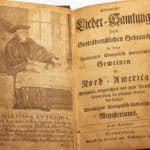

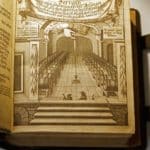
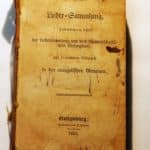
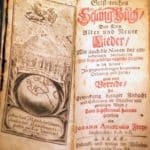

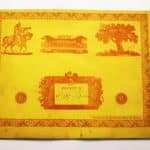
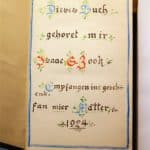



Related posts: